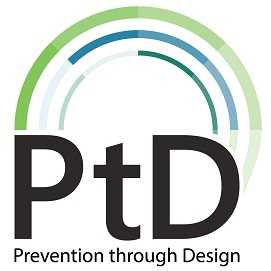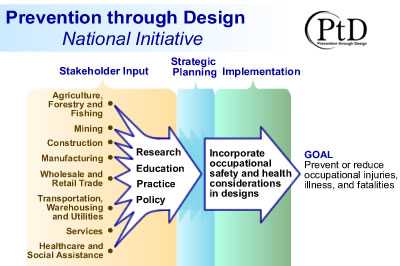PREVENTION THROUGH DESIGN
On this Page

Overview
One of the best ways to prevent and control occupational injuries, illnesses, and fatalities is to "design out" or minimize hazards and risks. NIOSH leads a national initiative called Prevention through Design (PtD). PtD's purpose is to promote this concept and highlight its importance in all business decisions.
Program Mission
The mission of the Prevention through Design National initiative is to prevent or reduce occupational injuries, illnesses, and fatalities through the inclusion of prevention considerations in all designs that impact workers. The mission can be achieved by:
- Eliminating hazards and controlling risks to workers to an acceptable level “at the source” or as early as possible in the life cycle of items or workplaces.
- Including design, redesign and retrofit of new and existing work premises, structures, tools, facilities, equipment, machinery, products, substances, work processes and the organization of work.
- Enhancing the work environment through the inclusion of prevention methods in all designs that impact workers and others on the premises
The strategic plan establishes goals for the successful implementation of the PtD Plan for the National Initiative. This comprehensive approach, which includes worker health and safety in all aspects of design, redesign and retrofit, will provide a vital framework for saving lives and preventing work-related injuries and illness is the roadmap.
Defining PtD
PtD encompasses all of the efforts to anticipate and design out hazards to workers in facilities, work methods and operations, processes, equipment, tools, products, new technologies, and the organization of work. The focus of PtD is on workers who execute the designs or have to work with the products of the design. The initiative has been developed to support designing out hazards, the most reliable and effective type of prevention.
Approach to PtD

The approach that will be used to develop and implement the PtD National Initiative will be framed by industry sector and within four functional areas: Research, Education, Practice, and Policy. As the chart below indicates, this process encourages stakeholder input through a sector-based approach consistent with the one used under the National Occupational Research Agenda (NORA).
The ultimate goal of the PtD initiative is to prevent or reduce occupational injuries, illnesses, and fatalities through the inclusion of prevention considerations into all designs that impact workers. Along the way, intermediate goals will be identified to provide a path toward achieving the ultimate goal. NIOSH will serve as a catalyst to establish this Initiative, but in the end, the partners and stakeholders must actively participate in addressing these goals to make PtD business as usual in the 21st century.
News & Events
The Prevention through Design program is pleased to announce the publication of the PtD Program-Performance One-Pager (PPOP), May 2016. We also invite you to view PPOP summary sheets for other NIOSH programs here: www.cdc.gov/niosh/docs/ppop
The Prevention through Design program is pleased to announce the publication of The State of the National Initiative on Prevention through Design (PtD) .
Engineering Modules Released
The Prevention through Design Program is pleased to announce the release of four education modules, consisting of an Instructor’s Manual and a slide deck. Each module outlines the motivations for PtD, encourages inclusion of worker health and safety considerations early in the design process, and identifies hazards associated with the topic.
- Page last reviewed: October 9, 2013
- Page last updated: July 29, 2016
- Content source:
- National Institute for Occupational Safety and Health Education and Information Division


 ShareCompartir
ShareCompartir